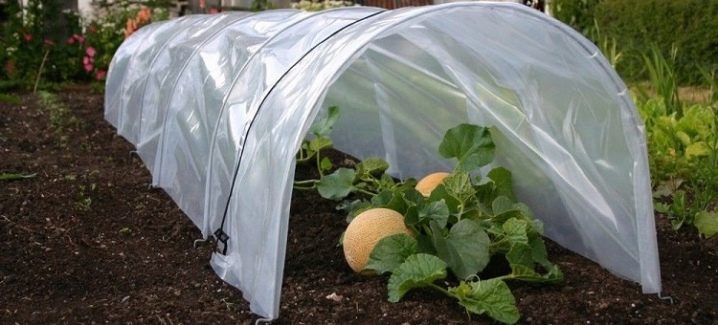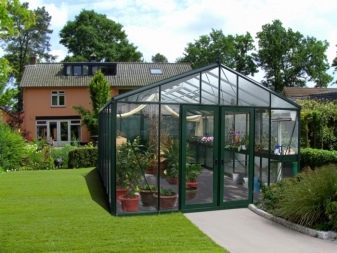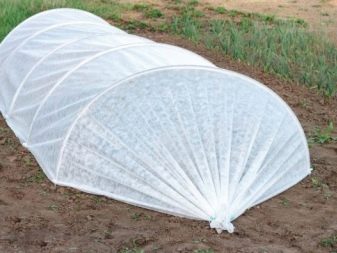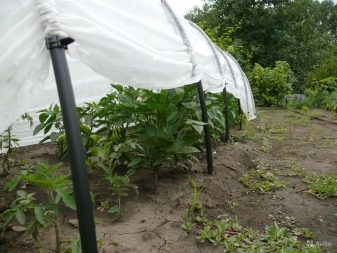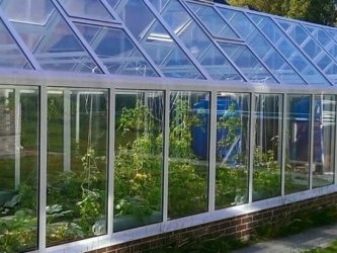How to choose a covering material for greenhouses?

Protection of garden crops and the provision of optimal conditions for their growth are the main tasks of gardeners. To solve them, special materials are needed that meet certain local conditions. The effectiveness of their use implies an understanding of the requirements for coverage, knowledge of its types and characteristics, the ability to choose the best.
Requirements
Covering material determines the qualitative and quantitative characteristics of the crop. The choice of the optimal variant depends on the whole complex of conditions. The variety of modifications can be reduced to several basic requirements.
The functional consistency of the material for greenhouses is provided by:
- good light transmission;
- counteracting harmful ultraviolet radiation;
- heat capacity to optimize the microclimate;
- resistance to climatic effects;
- ease of cleaning;
- ease of installation;
- reasonable price.
Buying material that has all the necessary characteristics is an impossible dream. Remains a reasonable choice, focused on personal priorities and local characteristics. Each owner acts individually. You can significantly save money by simplifying the design. To obtain the maximum amount of the crop is to focus on creating comfortable conditions for seedlings.
Kinds
Usually share the main structural types of shelter:
- hard;
- soft
Typical representatives of the first - coating of glass and polycarbonate. The second one includes films of PVC, polyethylene, reinforced, non-woven covering material.
Choose the best option - the main task in the construction of the greenhouse. It defines the construction of the structure and its functionality. It depends on the quality and volume, as well as the intensity of ripening of grown garden and berry crops.
Key Features:
- Light conductivity.For plants whose life cycle is based on the process of photosynthesis, it is a determining factor. High throughput will provide a growing culture with vital energy and eliminate the need for additional highlighting in the spring.
- Persistence The ability to resist natural forces, temperature extremes and precipitation.
- Thermal insulation. The property allows to provide the necessary temperature. This will avoid the additional costs of using radiators.
- Mass and plasticity. Low weight will significantly save on greenhouse construction, and plastic qualities will simplify and speed up its installation.
To date, five types of materials are actively used to shelter garden crops.
Film
The ancestor of the film greenhouses were fabric covers. They were used in the last century. The obvious advantages ensured their budget. The main advantage of the film material is effective heat retention and protection from climatic influences. The fragility due to low strength is compensated by cheapness, which makes it possible to change the coating on the seasons. The recently introduced reinforced film type has a long service life.
The main disadvantage of this type of coating is the membrane effect. Condensate is abundantly formed on the inner side of the film, the material does not pass air masses and humidity at all.
Film coatings are:
- light stabilized;
- reinforced;
- possess scattering;
- copolymer, ethylene vinyl nitrate;
- cellophane;
- thermocouple (foamed).
All these materials are successfully used for arranging greenhouses and greenhouses. Making a choice, the main attention should be paid to the characteristics and technical features of the material. Thus, residents of regions with large precipitation in the winter are actively using reinforced film.
Polycarbonate
More expensive coverage - cellular polycarbonate. This is quite a new material. It has considerable plasticity, which has a beneficial effect on the installation process, as well as the merits inherent in the coating of glass and polyethylene.
Leading characteristics:
- increased thermal insulation;
- high light transmittance;
- effective protection of crops from exposure to ultraviolet radiation;
- resistance and resistance to atmospheric and climatic influences.
Low thickness polycarbonate bends easily.However, there are drawbacks - its considerable price and not the most simple installation work.
Glass
Some home greenhouses glaze. This is a traditional material in order to cover industrial greenhouses. The main advantages of glass are reliability and absolute light conductivity.
The obvious advantages are balanced by two disadvantages - fragility and great weight. This greatly increases the complexity of installation and the amount of consumables. In addition, the specifics of working with glass presupposes the presence of certain skills that are not all. Usually glass is covered by greenhouses professionals.
Agrofibre
This material has largely solved the problem of strength inherent in film coatings. Agrofibre is made on the basis of polymer fibers, which gives it sufficient wear resistance, unlike the fabric coating. The most common types are called agrospan and agrotex.
Main advantages:
- low mass;
- optimal price;
- presence of the possibility of diffuse lighting;
- ease of installation operations;
- ability to pass moisture.
A significant disadvantage that this non-woven material has is low thermal insulation, which leads to additional costs in the spring and autumn seasons.
Spunbond
The most popular cover home greenhouse structures. Available in polymer fibers.
Benefits:
- provides the necessary light mode and necessary humidity;
- the possibility of watering the crop through the coating;
- ability to withstand temperature extremes;
- strong and resistant to aggressive influences (top dressing, fertilizers);
- possesses UV stabilization, protecting from harmful rays;
- provides a slow change in temperature;
- freely wiped, does not take up much space;
- operated up to six seasons.
An obvious disadvantage is the urgent need to cover the greenhouse structure with films from excess moisture during precipitation.
Spunbond is made from polymers.
There are 2 types of material:
- black (used for mulching the soil, protecting seedlings from weeds, warming seedlings);
- white (shelter greenhouse design).
Selection criteria
Short-term operation, for example, when growing seedlings before planting in open ground, suggests the possibility of covering the plant with a cheap film. Intensive use (spring / autumn) will provide polycarbonate.Small greenhouses it is better to seasonally overlap an inexpensive plastic film.
Greenhouse complexes on large areas with wooden or metal frames require glazing or polycarbonate coating. Such a covering material will ensure the reliability and year-round operation of greenhouses.
Cultivating particularly demanding crops may require shelter beds with material that provides good ventilation. For this you can use cloth. In the case of seedlings that need enhanced UV protection, reflective material is selected.
Usage tips
- The optimum thickness of polycarbonate is from 6 to 8 mm. Such material is convenient for covering greenhouses with large pitch of the batten.
- Under the influence of solar heat polycarbonate increases in size, and decreases in cold weather. The increase in temperature leads to the inevitable expansion of the material at the rate of 0.065 mm / m by one degree Celsius. Neglect of this feature may entail the deformation of the coating and frame. Tolerances must be left between the structure and the coating.
- To maintain light transmittance, polycarbonate must be cleaned several times a year. Usually a solution of soap or weak non-aggressive detergents is used, so the necessary transparency is maintained.
- When arranging a tension tent, it is necessary to provide protection of the coating against climatic influences. These measures assume the shelter of an awning with a polyethylene film during bad weather and its removal during the solar period.
- Polyvinyl film is different from other covering materials characteristic yellowish tint on the cut of the roll.
- Materials of unknown manufacturers offering goods at a low price will most likely lead to additional expenses for operational activities and consumables afterwards.
- A fabric stripe with stitches sewn along the center of the spunbond web helps you to mount the cover on the frame. This will eliminate the need for additional reinforcement.
- It is recommended to cover fabric covers and film coverings with wooden slats to minimize the sailing effect.
- Spunbond is especially effective in combination with films.When the roof is covered, the life span of the spunbond increases, the circulation of air in the structure is preserved, reducing the cost of watering and ventilation.
- “Used” agrofibre, more unsuitable, is successfully used as protection against cold and snow for seedlings, as well as perennial plants.
- When jointly growing several different crops in the same greenhouse, it is recommended that they be separated by strip of film.
- Before winter, polyethylene is removed, washed, dried and stored in a dry place. Glass and polycarbonate coatings are also cleaned.
- Defects identified during the season should be removed in the fall, without leaving it until spring. If the construction of the greenhouse has metal parts, they must be lubricated.
- The optimal size of any greenhouse dacha are: 2.5 m - the highest point, 3.5 m wide. These sizes are optimal for the care of plants.
- The doorway of the greenhouse is made on the basis that a garden cart passes through them.
Examples
Frame greenhouse structures covered with polycarbonate 4-10 mm thick. It should be remembered, the greater the thickness, the greater the weight.Thus, a 10-mm coating can not stand any frame. In winter, you should add on the load of snow cover, significantly increase the requirements for the strength of the frame. For medium greenhouses, the right choice is a 4- or 6-millimeter sheet of polycarbonate.
Glass is a tough material, it is well suited for structures with single and double gable roofs. Glazed greenhouses can be seen near the houses of gardeners. They are effortlessly assembled from used frames. Their main advantage is budget.
Such coating greenhouses withstand significant loads. Replacing broken or cracked glass is usually not a problem. The main advantage of glasses - they are transparent. Plants under this coating will always have enough heat and light.
Reinforced coating instead of the usual polyethylene is very popular.
This is a special canvas, which consists of 3 layers:
- polyethylene;
- reinforcing mesh;
- polyethylene.
The material has a characteristic feature - when stretching the coating increases strength. The polymer component of the film binds the mesh for reinforcement with the outer layer.
The main advantage of non-woven modern greenhouse coatings is the ability to "breathe." In addition, such coatings have insulating features.The light tones of agrotextiles are used in the protection of plant moss, the dark one plays the role of mulch.
A variety of materials is amazing. Often, agrotextiles are used as material for greenhouses in the springtime.
Polyethylene does not need advertising. This is the oldest and most traditional covering material. The film is obliged by the breadth of its application to the old days when there were no other means for plant protection. Its main place - small greenhouses, household plots and gardens. Demand contributes to low cost and prevalence. To work with the film does not need experience and special skills, it has a high ability to transmit rays. Having a small weight, plasticity, the film is used to shelter greenhouses on a light frame.
The special attraction of such an option as a gable greenhouse is that almost any material is suitable for its construction (remnants of bars, old frame, metal profile, etc.). This construction is covered with glass, polycarbonate sheets, film, spunbond, etc. In use, the gable design is very convenient. There is no need for squatting and strong bending. It will not be difficult to reach the bushes against the wall.In winter, the structure is not threatened by the collapse under the weight of the snow mass, since it cannot linger on the inclined surfaces of the structure.
This option surely exists as a separate design, and the wall. To use the greenhouse in winter, the planes of a gable roof are covered with polycarbonate or glass. Seasonal construction is covered with plastic films.
The gable greenhouse is an excellent place to grow tomatoes, cucumbers, peppers, tall bushes (warm air masses accumulate in the upper parts). For the prevention of stagnation or overheating of air, special attention is paid to the design and organization of the ventilation system. This will save plants from the development of many diseases.
Optimal ventilation of the gable design is a system of several air vents. If necessary, install a forced air ventilation system in the greenhouse. It is worth remembering the danger of drafts, ruining growing crops.
The variety of constructive solutions to protect seedlings should not be a source of difficulty in creating their own greenhouse project.In the event of controversial issues, it is strongly recommended to be guided in the choice of expensive materials and import frames by the opinion of professionals.
For information on how to choose a covering material for greenhouses, see the following video.

















